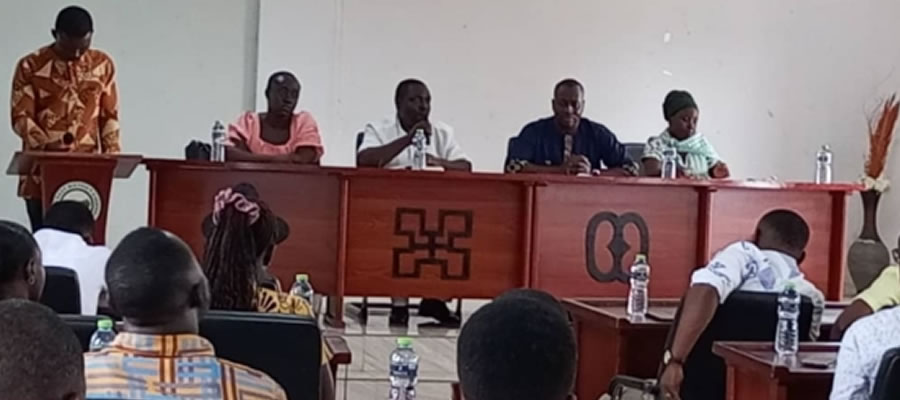

Physical and Natural Environment
Introduction:
The Atiwa East District Assembly is one of the thirty - three (33) districts in the Eastern Region of Ghana; it gained its present status by the Legislative Instrument (LI) 2344 of 2018. It was carved out from the then Atiwa District Assembly now Atiwa West District Assembly, in the year 2018. Its Capital is Anyinam which is situated on the Kumasi Accra high way near Osino.
Location and Size
The Atiwa East District covers a total area of 625.78 square kilometers lying between longitudes O° 3? West and O° 50 East and latitudes 6° 10? North and 6° 30? South. The District is bounded on the North by Kwahu West and Kwahu South Districts, on the North-East by the Fanteakwa South District, Abuakwa South to the South-East, Kwaebibrim to the South and Birim North to the West. The strategic location of Atiwa East District Assembly, sharing boundaries with districts that are famous in agricultural production, provides an opportunity to develop agro processing facilities to make use of raw materials from these areas.
The large area under the jurisdiction of the District has implication for many small settlements whose population may not measure up to the population threshold for provision of certain socio-economic infrastructure. The district requires enough financial resources to be able to close the infrastructure gap.
The district is divided into four (4) Town/Area Councils namely Anyinam, Sekyere, Asamang-Tamfoe, and Kadewaso and Eighteen Assembly members including the Hon. Member of Parliament and the Hon. District Chief Executive with their population thresh of more than 1,000 people. The rest of the settlements have population less than 1,000 people in each settlement.
Relief and Drainage
The gentle and undulating land rises about 240m to 300m above sea level with the highest point at the Atiwa ranges which rise over 350m above sea level. Different types of rocks formed gave the different relief features, which include flat bottom valleys to steep-sided high lands which are covered with iron pans, bauxite and kaolin. The steep sided highlands have created some wonderful sightseeing waterfall around Adasawase, Pameng and many other places.
The Birimian rock formation covered over (75) percent of the forest zone. Granite occurs in parallel belts and contains different mineral deposits. Major perennial rivers like, Birim, Densu, Adenchensu, Merepong and Pra have their catchment areas within the Atewa forest with other several seasonal streams in the District. The pattern of flow is largely north-south direction and very good water drainage basic in the district.The rock formation has significant implication for growth of the quarry industry which can enhance the production of chippings for road and housing construction. The unique rock formation resulting in development of waterfalls provides great potentials for tourism development. Effort should be made to identify these natural attractions for economic development.
Climate Condition
The District lies in the wet semi equatorial zone characterized by a bi-modal rainy season, which reaches its maximum during the two peak periods of April-July and September-October. The annual rainfall is between 1,250mm and 1,750mm.Temperature ranges between a minimum of 26°C and maximum of 30°C. The District has a relative humidity of 65-75 percent during the dry season and 75-80 percent in the rainy season. This climate is very good for agriculture for both food and cash crops. Farmers are encouraged to go in to cash crops such as cocoa, citrus and palm plantations. The District Assembly needs to assist private individuals to go into Agro-processing industries to be able to process the agricultural products.
Vegetation
The District is located within the mist semi-deciduous forest. The forest reserve covers the Atiwa Scarp and its surroundings. Larger proportion of the district is green, a characteristic of semi-deciduous forest. Commercial tree species covering 12% land area include; Odum, Wawa, Ofram, Asamfra, Mahogany, Okyenkyen etc. The vegetative cover is suitable for agricultural and agro-based industrial activities including food processing, wood processing. However measures be put in place to protect the natural environment from illegal logging and illegal small scale miners.
Biodiversity, climate change, green economy and environment in general
The District is located within the mist semi-deciduous forest. The forest reserve covers the Atiwa Scarp and its surroundings. Larger proportion of the district is very green as semi-deciduous forest. However, the problem of pollution and environmental degradation in the district by illegal artisanal small scale mining and indiscriminate felling of trees has in recent past become a major concern to the District Assembly.
The activities of illegal chain saw operators and illegal miners as well as small scale miners continue to threaten the forest cover and the environment. The miners are degrading the land with impunity through excavation for the minerals and spillage of dangerous chemicals. The situation has been aggravated by the activities of the illegal miners who undertake their activities in secret without recourse to lay down mining laws and regulations.
As a result of abuse of the environmental resources, some settlements are experiencing environmental degradation. There is high incidence of abandoned pits and poor drainage system. A significant part of the land, forest, wildlife and water resources are seriously threatened by the abuse of the resources. Illegal mining (Galamsey) has been a major challenge to the environment and agriculture in the District as vast arable lands have been lost to artisanal small scale mining. The water bodies used for irrigating vegetable farms are also polluted with toxic mercury and other chemicals.
Date Created : 3/28/2019 3:58:20 AM












 facebook
facebook
 twitter
twitter
 Youtube
Youtube
 +233 593 831 280
+233 593 831 280 0800 430 430
0800 430 430 GPS: GE-231-4383
GPS: GE-231-4383 info@ghanadistricts.com
info@ghanadistricts.com Box GP1044, Accra, Ghana
Box GP1044, Accra, Ghana